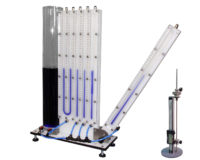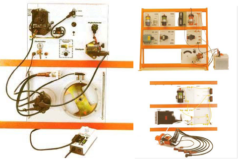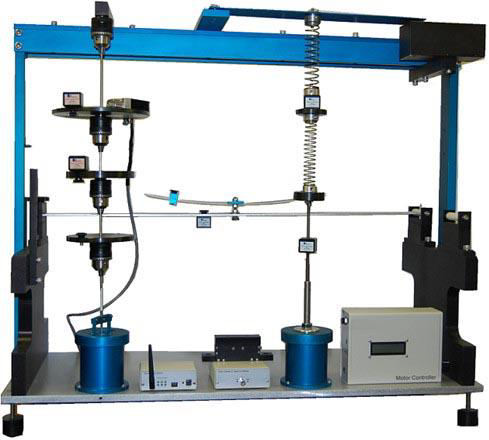Vibrations Fundamentals Training Kit Model MT 128
Home » Products » Vibrations Fundamentals Training Kit Model MT 128
Vibrations Fundamentals Training Kit Model MT 128
Sci-tech Vibrations Fundamentals Training Kit Model MT 128 is an innovative tool you can use for teaching the fundamental principles of mechanical vibration. MT 128 is well researched and designed for immediate implementation for vibration laboratory development. It is can be easily integrated with a typical vibration course taught at most institutions. MT 128 provides a comprehensive hands-on experimental device, an instrumentation package, and experimental program with course curriculum for performing laboratory exercises to enhance student understanding of vibration theory. The bench-top apparatus has a spacious modular design featuring versatility, operational simplicity, and robustness. Each component is machined to high tolerances so it can be operated without conflicting vibration in a totally controlled environment. The instrumentation package includes wireless less accelerometers and transducers, precision servomotor for excitation, tachometer, and four channels simultaneously sampled data acquisition hardware, signal conditioners, and time and frequency domain analysis software. Optionally included are a software simulation of theory and a well-defined experimental program for free and forced vibration experiments ranging from single degree of freedom spring mass to continuous beam with different boundary conditions. Students can perform both hands-on and virtual experiments to optimize the learning. MT 128 is designed to perform both free and forced vibration experiments with and without damping. The basic MT 128 frame consists of two identical test stations mounted on a portable structure. It features into changeable restraint fixtures, optional force transducers to measure the support reactions, sensors to measure deflection and acceleration, and a variable frequency rotary shaker for forced excitation. It allows for the first time to perform almost damping free vibration experiments to verify the theory.
| Size: | 120cm x 60cm x 180cm (LxWxH) |
| Weight: | 35 kg |
Item Description
Features
- Clarify difficult concepts of vibration theory by performing hands-on controlled experiments
- Perform both free and forced natural vibration experiments without damping
- Validate theoretical predictions of natural frequencies, mode shapes, and frequency response as a function of frequency, boundary conditions, geometry, and materials
- Validate theoretical concepts by comparing experimental results with the computer simulation of the vibration theory
- Determine the detrimental effects of vibration load transmission to the support structure and component fatigue life
- Learn to control vibration amplitude using tuned mass dampers and damping treatments
- Learn vibration measurement transducers, signal processing, data acquisition and data analysis
Sci-tech Vibrations Fundamentals Training Kit Model MT 128 is a turn-key integrated educational package for teaching/learning the fundamental principles of mechanical vibration as well as engineering mechanics. It provides both a comprehensive hands-on experimental device and an instrumentation package including wireless sensors for performing laboratory exercises to enhance student understanding of vibration theory.
MT 128 clearly brings classical theory to life by providing a convenient mean to validate predictions and to demonstrate the influence of parameter changes on system response visually. Students can perform virtual experiments using the vibration simulation software and then verify the results with actual experiments thereby reinforcing the learning of difficult principles. MT 128 provides an ideal tool for damping free vibration experiments using the wireless sensors without affected by the damping associated with the sensor cables. It is a perfect tool for teaching mechanical vibration courses both at under graduate and graduate levels.
With an increase in high-speed manufacturing and automation, it has become more important to use the theory of vibration for design and maintenance of machinery. This vibration theory is even more important in the monitoring and diagnosis of machinery malfunctions. Considering the importance and complexity of vibration principles, a course curriculum should include laboratory demonstration and hands-on experiments to help students understand the somewhat abstract concepts of vibration. To this date, most academic institutions include only theoretical lectures without laboratory exercises due a lack of an apparatus combined with an instrumentation setup.
Sci-tech Vibrations Fundamentals Training Kit Model MT 128 is an innovative tool you can use for teaching the fundamental principles of mechanical vibration. MT 128 is well researched and designed for immediate implementation for vibration laboratory development. It is can be easily integrated with a typical vibration course taught at most institutions. MT 128 provides a comprehensive hands-on experimental device, an instrumentation package, and experimental program with course curriculum for performing laboratory exercises to enhance student understanding of vibration theory. The bench-top apparatus has a spacious modular design featuring versatility, operational simplicity, and robustness. Each component is machined to high tolerances so it can be operated without conflicting vibration in a totally controlled environment. The instrumentation package includes wireless less accelerometers and transducers, precision servomotor for excitation, tachometer, and four channels simultaneously sampled data acquisition hardware, signal conditioners, and time and frequency domain analysis software. Optionally included are a software simulation of theory and a well-defined experimental program for free and forced vibration experiments ranging from single degree of freedom spring mass to continuous beam with different boundary conditions.
Students can perform both hands-on and virtual experiments to optimize the learning. MT 128 is designed to perform both free and forced vibration experiments with and without damping. The basic MT 128 frame consists of two identical test stations mounted on a portable structure. It features into changeable restraint fixtures, optional force transducers to measure the support reactions, sensors to measure deflection and acceleration, and a variable frequency rotary shaker for forced excitation. It allows for the first time to perform almost damping free vibration experiments to verify the theory.
See also different:

Sci-tech Fluid Statistics & Manometry Apparatus Model FM 56 provides an introduction to the behavior of liquids under hydrostatic conditions (fluid at rest) and the application of these principles to pressure measurement using manometers. [...]

Sci-tech Automotive Ignition / Charging Demonstration Trainer Model AM 165 is designed to teach students principles of Ignition system used in modern vehicle through comprehensive practical activities. The activities include semiconductor fami [...]

Sci-tech Basic Satellite Communication Trainer Model TCM 006 is the first of its kind using actual techniques of satellite communication. It can uplink a given signal to a satellite link emulator, which can be stationed far away. The satellite [...]

